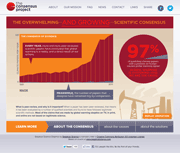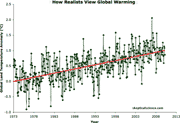Do Americans really want urban sprawl?
Posted on 17 March 2025 by Guest Author
This is a re-post from Yale Climate Connections by Sarah Wesseler
(Image credit: Antonio Huerta)
Growing up in suburban Ohio, I was used to seeing farmland and woods disappear to make room for new subdivisions, strip malls, and big box stores. I didn’t usually welcome the changes, but I assumed others did. If people didn’t want to live in sprawling suburbs, why did I see this kind of development everywhere I went?
But the situation is more complicated than it seems. Although sprawling development is still a familiar sight across the U.S., many experts in urban planning and housing believe this doesn’t occur because of a uniquely American passion for giant parking lots, but as a result of a dysfunctional market. Many people are hungry for denser, more walkable communities, they believe; there just aren’t enough of them to go around.
The question of what kind of communities Americans prefer has important implications for climate change. Suburban U.S. households have substantially higher emissions than their city-center counterparts, largely due to cars. Building more dense, walkable developments could significantly lower these emissions – assuming enough people would both choose to live in such communities and find suitable housing there.
How single-family zoning limits housing choices
Jonathan Levine, a professor of urban and regional planning at the University of Michigan, has been thinking about these issues for decades.
“What you thought, that we have sprawl because people want sprawl: That really was the dominant view around the turn of the 21st century,” he said.
His 2006 book called this idea into question. Its argument: Zoning has distorted the American real estate market, limiting housing options by making common elements of sprawl the only form of development allowed across much of the nation. In many cities, land-use regulations make it illegal to build town houses, duplexes, apartment buildings, granny flats, and the like – anything other than single-family homes – on around 75% of the land zoned for residential use. In some places, this figure rises above 90%.
“Some people say, ‘Americans want big houses on large lots,’” Levine said. But “if it were the case that all Americans wanted big houses on large lots and could afford big houses on large lots, would we need single-family zoning? Absolutely not … The very fact that we enact these zoning regulations in such an exclusionary fashion as we do in the United States is evidence that we’re defending against something. And that something is the desire of people – not all people; some people – to live closer in, accepting higher densities, maybe more urban living styles, etc.”
Nearly two decades later, this position is no longer controversial among his peers, Levine said. Greater awareness of the harmful impacts of land-use regulation, as well as soul-searching in the wake of the subprime mortgage crisis, has led to a dramatic shift in opinion.
“The [urban] planning profession, the economics profession, and academia are very much focused on the negative effects of zoning that constrain densities to overly low densities,” he said. “They see it as an impediment to the market providing the kinds of things that people want.”
What do surveys say?
As the downsides of sprawl have become increasingly clear in recent decades, advocacy groups have formed to push for alternative forms of development. One of them, the smart growth program at the National Association of Realtors, a trade association for real estate agents, was created in 2000 after agents noted that although their clients increasingly wanted properties in walkable areas, there weren’t enough available to satisfy the demand.
 Walkable communities can come in different forms, offering various housing types and streetscapes. (Image credit: Antonio Huerta)
Walkable communities can come in different forms, offering various housing types and streetscapes. (Image credit: Antonio Huerta)
“The term ‘smart growth’ came about in the mid-90s, roughly, as a reaction to the 40 or 50 years of sprawl development that we’d had,” said Hugh Morris, who has led the National Association of Realtors program for the past six years. “It became clear that there were some negative consequences to that kind of development.”
One of the program’s goals is to provide information about Americans’ real estate preferences to help guide decision-making about development and policy. To this end, Morris has surveyed 2,000 people in the nation’s largest 50 metropolitan regions every two years for the past decade to understand which qualities they look for when deciding where to live, asking about factors ranging from home and yard size to highway access, sidewalks, crime, and school quality.
The results show that “the desire for walkability has been increasing steadily, really, since 2015, to the point where it exceeds the desire for single-family/drive-only locations to a degree that is beyond the margin of error,” he said. In the 2023 survey, 56% of respondents said that if they were to move, they would accept a smaller yard as a trade-off for a more walkable neighborhood. Asked to choose between a house in a car-dependent area and a town house or apartment offering a shorter commute and walkable shops and restaurants, 53% chose the latter (an 8% increase from 2015).
Not all questionnaires examining Americans’ housing preferences have reached the same conclusion, however. In a one-question survey on this topic conducted by Pew Research Center in 2023, 53% of 5,079 respondents drawn from across the nation said they would prefer to live in a community with houses that are larger and farther apart with schools, stores, and restaurants several miles away as opposed to one where homes are smaller and closer together with walkable schools, stores, and restaurants. Pew also conducted the same survey in 2021 and 2019, with similar results.
High prices indicate high demand
Michael Rodriguez, the director of research at Washington, D.C.-based nonprofit Smart Growth America, believes that asking people to explain their housing preferences in the abstract isn’t the most effective way to gauge demand for business-as-usual suburbia versus walkable alternatives.
“Everybody wants a little more space in their house; this is not very surprising,” he said. “It’s always a trade-off between space in your home and a commute and job access and amenity access.”
Studying the number of different kinds of housing units sold also provides an imperfect gauge of what Americans want, he said. “People are buying a lot of homes in the suburbs? Well, we don’t build them anything else,” he said.
While this statement may be an exaggeration, it highlights a real concern. In a 2023 report, Rodriguez and coauthor Christopher Leinberger wrote that in the nation’s 35 largest metropolitan areas, walkable neighborhoods accounted for only 1.2% of the land, on average, and that only 11.6% of all non-rental housing was located in those neighborhoods.
“Drivable suburban housing takes up by far the largest amount of land in those 35 metros, approximately 90%, and the low-density zoning and NIMBY [Not in My Back Yard] opposition has not allowed the market to produce walkable urban product without years of legal and neighborhood battles,” the authors noted.
 Walkable neighborhoods account for only a small area of the developed land in the largest American cities. (Image credit: Antonio Huerta)
Walkable neighborhoods account for only a small area of the developed land in the largest American cities. (Image credit: Antonio Huerta)
If survey responses and home sales don’t clearly tell us where Americans would most like to live, what can? The answer, according to Rodriguez, is money. His 2023 report showed that, across the country, people are willing to spend significantly more to buy homes and rent apartments and commercial spaces in walkable communities compared to car-dependent alternatives. In the 35 regions studied, 2021 home sale prices were an average of 34% higher in walkable areas, while rents for offices and multifamily housing in the same year were 44% and 41% higher, respectively, on average.
“That premium for walkable urbanism is a market indicator that tells us a lot of people really want this thing, but there’s not enough of it,” he said.
Jonathan Levine, who was not involved with the report, said that he agrees with its general findings.
“There’s no good reason why walkable urbanism should cost more than auto-oriented suburbia, especially since walkable neighborhoods use land more efficiently,” he wrote in an email. “But land-use regulations make it unnecessarily hard to build and expand walkable neighborhoods. As a result, the supply of these neighborhoods stays low, and households who prefer walkable neighborhoods are less likely to find (and afford) one that fits their preferences compared to those who prefer auto-oriented neighborhoods. This points to strong demand for walkable neighborhoods that could be met if regulations didn’t make their development so difficult.”
Density beyond downtown
It is possible to make car-centric areas more walkable, however, Rodriguez said, offering his own community of Tysons, Virginia, a suburb of Washington, D.C., as proof.
“You see what’s being built and the change that’s happened over the last 10 years – it is night and day.”
In recent years, the local government has invested heavily in making the area into what it describes as “a 24-hour urban center where people live, work and play” by 2050. As a result, land that was formerly devoted to parking lots now houses one of the tallest skyscrapers in the region, Rodriguez said, along with a performing arts venue that hosts traveling Broadway shows. “And now we have condos and apartment buildings right off the Metro [subway stop]. There’s a couple new hotels,” he said. “All that increases amenity, walkability, and gives people an option of somewhere to live near the Metro.”
This and similar projects demonstrate that it’s possible to achieve walkability outside of downtown areas, according to Rodriguez. “People want this form of living, and maybe they won’t want to be in the city center – that’s OK,” he said. “Increasingly, there’s more demand for it in the other areas where they live, in the, quote, suburbs.”































 Arguments
Arguments






























Tysons Corner is ok Tysons Corner via Google Maps
Reston Town Center is more attractive IMO. Reston Town Center via Google Maps
Merrifield near where I used to live is another transit-oriented mixed development with less success. Merrifield
Transit hubs heading towards Rosslyn and DC get increasingly sterile. The problem in general is too much pavement. Wildlife consists of house sparrows, pigeons and periodic large flocks of starlings.
The pandemic changed things although transit is picking up again. I live in a subdivision with 5 acre lots. My nearest strip mall is about 12 miles away but it's fairly efficient to go just once a week. Work is 75 miles and I go once a week out of habit more than anything else.
It boils down to the basic human need of in-person social interaction. I know most of the neighborhood walkers and dog walkers and visit a few friends within 20 minutes. Monthly coin club meeting in person and HOA every other month. The rest is online or text and that's kind of inadequate. The reason for walkability is not because you have to but because you want to.
If you work from home here in Northern Virginia and want to be walkable but within driving distance for an occasonal commute you might choose Charlottesville or many other smaller towns away from the city.
The walkable city concept is great in theory and could work - provided it has highrise apartments that are of excellent design and reasonably spacious not shoe boxes, with nice views and very high levels of noise insulation and decent heating and cooling, and plenty of decent sized balconies, and local parks, and plenty of facilities within walking or maybe cycling distance. And that will be expensive. And that is the problem.
nigel's comment about people wanting decent places to live is an important one. ("Decent" is a highly-subjective concept.)
In the Canadian province where I live, the largest city is Toronto. There has been much development of condominiums in the downtown area - but there has been an ongoing trend to shoe boxes. Developers have made lots of money with this approach - in part because many of the condo developments saw brisk pre-build sales to investors. The investors paid in under the expectation that prices would rise and they'd be able to sell at a profit as soon as the development was finished (or even before...) Even if they didn't sell, rental rates were high enough to allow the investor to rent it out and cover all their costs.
Very few of the shoe-box condos were being bought by people that planned to live in them for a long time.
The market has changed. Interest rates are up, prices are down, and many investors that had bought condos via pre-build sales are finding that as the projects approach completion they will be unable to sell for what they agreed to pay - and in some cases they will be unable to get mortgages for the amount they need to close on the sale. They risk losing their deposits when they back out of the purchase - and may be liable for costs when the developer has to sell at a lower price to a different buyer. And rents are lower, so completing the sale still risks owning a money-losing property where rent does not cover the mortgage, condo fees, etc.
Developers were in the business of meeting a demand for investment property. They were not doing a good job of producing livable, decent housing that people would want to consider "home".
Regarding Bob Loblaw’s comment @3,
The CBC About That presentation by Andrew Chung: Why are so many big-city condos sitting empty?, is a great presentation of what Bob shared.
In my comment @4 the presentation is by Andrew Chang not Andrew Chung.
Regarding nigelj’s comment and expanding onto other points.
Walkable development does not require expensive high-rise buildings. But it can be expensive to redevelop built cities to be walkable. However, the bigger issue is the ways that misunderstandings can be exploited by people who want to impede efforts to develop sustainable improvements.
Walkable development can be effective with multi-use buildings less than 10 stories high. The lower floors could be commercial uses with the upper floors being residential. (Note: This NFSA blog post from 2020 states that the International Building Code – It is not International. It only applies in regions of the US that choose to adopt it. But that is another matter – defines a high-rise as, “a building with an occupied floor located more than 75 feet (22,680 mm) above the lowest level of fire department vehicle access.”)
Very walkable cities developed before ‘car-based sprawl’ and ‘downtowns filled with skyscrapers’ became misleading symbols of superiority.
Cities that developed based on the desire for ‘car sprawl’ and ‘downtown office skyscrapers’, like Calgary, Alberta (where I live), are very expensive to ‘re-develop to be walkable’. That is unfortunate because those cities are at a competitive cost disadvantage if they do not re-develop.
People living in ‘car-sprawl’ cities ‘need’ less expensive housing due to the high cost of ‘car ownership’ (internet searching will find many estimates that it costs more than $10,000 per year to be a car owner). Those cities also have higher costs to build and maintain their sprawling public service infrastructure (roads, water mains, sewer mains, power distribution ...).
The ‘car sprawl’ cities have also developed a cultural attitude that resists sensible changes, like the change to be ‘a more walkable city’.
There is a global collective that develops misunderstandings in opposition to efforts to limit the harm done by fossil fuel use. A massive percentage of Calgary’s wealth potential is from ‘limiting the limiting of harm done by fossil fuel use’. That ‘opposition to learning to be less harmful’ includes political misleading messaging to promote misunderstandings about actions like carbon pricing. The following article presents a connection between opposition to carbon pricing and opposition to walkable cities.
The Hub - Steve Lafleur: The Liberals have kneecapped the carbon tax. Now we need walkable cities more than ever
There is powerful opposition in Calgary to efforts to increase density and redevelop already built areas to be more walkable and higher density. The following articles are examples. They do not represent all of the Calgary opposition to ‘learning to live less harmfully’.
Calgary Herald - Legal fight against city's blanket rezoning decision rages on, headed for appeal
CTV News Calgary - Glenmore Landing redevelopment defeated by vote at Calgary council
Note that the area councillor supported the development and mentioned her attempts to address misunderstandings. The development was opposed by councillors of other areas of the city who repeated misunderstandings about the proposed development. The following article is about a different council member attempting to more officially investigate and address those misunderstandings.
CBC News - Calgary city councillor wants review on impacts of false information
The suggestion that the popularity of misunderstandings was a serious concern prompted misunderstandings in response
Calgary Herald - Opinion: Is a Ministry of Truth coming to Calgary?
The Calgary opposition to ‘walkable 15-minute’ development is almost certainly a key part of the unjustified global collective that opposes ‘learning to be less harmful and more helpful to Others’ (a ‘big-tent’ collective of misleading promoters of a diversity of misunderstandings, including climate science misunderstandings).
And the ‘walkable 15-minute’ misunderstandings are related to efforts opposed to better understanding of climate science (refer back to The Hub article link above). More walkable implies less car use, which would mean less potential for benefit from fossil fuel use (note that the Calgary councillor also wanted misunderstanding regarding Calgary’s rapid transit system development to be investigated).
The following article mentions the international conspiracy theory promotion of misunderstandings regarding 15-minute walkable development.
Queen’s University – The Queen’s Journal - Contrary to conspiracy theories, Queen’s professors say walkable cities improve quality of life
And the global group coordinating that ‘opposition to learning’ is also likely heavily involved in the opposition to other harm limiting actions like New York City’s Congestion Pricing (see this NYC ABC news item - Trump administration extends deadline for New York City to end congestion pricing)
There are a multitude of problems to be addressed and corrected by efforts to develop sustainable improvements. But almost all of the problems can be understood to be parts of a global collective that wants to benefit by developing and promoting misunderstandings to limit ‘learning to be less harmful and more helpful to Others’.
One Planet said "(internet searching will find many estimates that it costs more than $10,000 per year to be a car owner)"
Isn't that part of the same consumption problem that underlies a lot of the energy intensity of the economy? My Ford Focus has 347,000 miles and it costs about $3,600 in gas and $1,000 (give or take) in other expenses per year. 40,000 miles a year is the reason my costs are so high. Some of that mileage is to see family in New England, but some could be reduced. I know some people with lower car expenses and people with higher. The higher ones are mostly "overconsumers" IMO.
Roads for cars is indeed a problem, but you also need to consider roads for trucks including "walkable" cities. Careful design could alleviate the need for heavy trucks that wear out roads. The worst case is cement mixers with 10 tons per axle but there are alternatives if you want to be careful about road wear.
Thanks for posting the video about condo prices. It was nominally focused on "investment" when in fact all of the people involved were speculators, not investors. Also the reporter did not give a sustainability perspective. He didn't ask the question of how long hastily constructed condo buildings will last. Nor any other sustainability issues.
Your Lafluer article raises some questions when he says "There’s no reason why someone in a cul-de-sac should be forced by the zoning code to hop in his car to get a loaf of bread or grab a coffee." Why do they need a loaf of bread or coffee? Because fresh food is better tasting? People can make their own fresh bread and coffee.
The answers are pretty simple: people walk because it's healthy and it's fun to go somewhere. They might walk to get a loaf of bread in which case there are economic benefits of division of labor, energy savings (more bread from one oven), lower capital costs, etc. In my neighborhood people walk from one great view to another on a mostly wooded road.
I agree completely with Lafluer's conclusion of better planning. But planning is very complicated when you take into all life activities including the need for socializing and nature.
The first Calgary Herald article was very interesting and highlights a common problem in many older cities. Arlington Virginia is dealing with the same problem, the city leaders want more development and most residents want NIMBY. They tried ADU: www.arlnow.com/2021/06/03/accessory-dwelling-units-begin-popping-up-in-arlington-backyards/ and that didn't really work. They tried "upzoning", very similar to that CH article, with years of NIMBY pushback. The other rezoning article (Glenmore Landing) reinforces the problem: change is hard because negative impacts are easier to envision than positive ones. For example, when I walk around high rise areas in Rosslyn VA I see a lot of reflected sun. Even the simple "shade from high rise" argument against high rises is nuanced.
The "Ministry of Truth" article is of course a red herring. The issue is not true vs false, but nuance, context, and of course the big picture. Posters at meetings, two-minute speeches, and short articles in the newspaper (often just opinion pieces) mostly miss the big picture.
There are many players and interests. I consider the NIMBY arguments against rezoning to be a form of anti-growth. But they miss the big picture too because we have increasing population in most places, and real estate growth is inevitable. The most urgent need IMO is to focus on the meaning, purpose and needs of life and ignore the politicans who are in bed with the developers. I would recommend ADU (with proper inspection) and very localized redevelopment where the big developers don't participate.
OPOF @6, I will clarify what I mean about highrise living in a walkable city needing to be expensive. I just suspect highrise apartment living ( define it as anything above about 7 floors) will have to be very high quality and thus quite expensive to entice middle class people away from suburban living, with its privacy and your own garden etc. People put considerable value on that. So it might be so expensive it doesnt attract very many people even if they save on car running costs and can walk to most things.
As you say converting cities to be walkable in a meanigful way is also going to be expensive and this adds to the cost problem. And it will have to be meaningful. People are mostly not going to move and sell the car just so they can walk to get a coffee. Most things will have to be within walking distance, including most work, shops, and services. And it will need very high density living and highrise apartments otherise too many shops would be needed to be economically viable. Its obvious.
But its good some places are experimenting with walkable city living, and we will see how things develop and whether it attracts enough people. I like the idea in principle. I live ten minutes walk from the local shops and its great. I hope it would work, but we also need some healthy scepticism.
Eric (skeptic) @7,
Thanks for the response. I generally agree with your observations. However, there are some minor clarifications I would make.
Regarding $10,000 per year for car ownership:
The energy costs are indeed highly variable. However, they are only a part of the costs. A fuller understanding of the costs of car ownership is presented by RateHub.ca - What is the total cost of ownership for a car? That evaluation concludes that the average cost in Canada is $1370 per month = $16,500 Cdn per year (~ $11,500 US). The costs include the following in addition to annual fuel and maintenance costs:
Regarding roads:
‘Car sprawl’ cities cover larger areas per capita (they have lower population density). That requires more length of roads and other public systems per capita. Calgary has 1.4 million people living on 825 square km. For comparison, Copenhagen, considered to be reasonably walkable, is 1.4 million living on 180 square km. The length of public infrastructure items in Copenhagen is likely about 1/4 the lengths (and costs) required by Calgary.
Regarding ‘Investors’ vs ‘Speculators’:
People who buy a property that they do not intend to live in can be called ‘investors’ or ‘speculators’. The same goes for people buying stocks or being venture capitalists. They are ‘investors who are speculating’ about the amount of benefit they will get from their actions. That is different from someone who ‘invests’ in a fixed interest deposit - no speculation in that action, except for speculating that it will be better than ‘riskier’ investment options. Note that the 2008/9 financial crisis was due to speculation that home-buying with balloon mortgages would be a good investment.
Regarding sustainability of the condos being built:
The consequences of the temptation to save money on the initial build is a concern. But the shoe-boxes in question wold be the same problem even if they are better-built than the average new high-rise building.
Regarding having to use a car to get a loaf of bread or a coffee:
The point being made is that in a walkable community you can walk to get a small amount of groceries. And there would be a local coffee shop (or two) you can walk to for a visit with friends (and you could walk to your friend’s place for a visit). Being able to walk to a diversity of shops and services, and even walk to work, would be possible in a walkable community.
nigelj @9,
As Eric (Skeptic) has mentioned there is complexity and nuance on many aspects of this matter.
It is probably more accurate to say “...highrise apartment living ( define it as anything above about 7 floors) will have to be very high quality and thus quite expensive to entice some middle class people away from suburban living, with its privacy and your own garden etc. Some [p]eople put considerable value on that.”
Many people ‘need’ less expensive ways of living. In the case of ‘car sprawl based development’ a lot of what was built is of little use to those people, but they pay for it because they have ‘no real choice’. Offering those people the choice of smaller less expensive housing - like affordable, but well-built, apartments that are 7 stories or less - could make ‘single family homes with big yards’ less valued if there were more lower cost alternatives.
In addition to opposition to actions that would reduce potential benefit from more fossil fuel use, the 'loss of potential value' of already built single family homes with yards would explain the misleading misunderstanding fuelled opposition to the Glenmore Landing development by councillors for other areas of Calgary (refer back to my comment @6).
Note that the council member for the community that the Glenmore Landing development affected, where it would be built, supported the development because her community member feedback was Not-NIMBY. The community supported the development. Other council members opposed it, and they repeated misleading misunderstandings as the reason for their opposition.